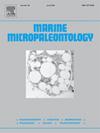Benthic foraminiferal population dynamics at the Goban Spur off Southwest Ireland reveal glacial-interglacial bottom water ventilation and organic flux variability over the last 420,000 years
IF 1.5
4区 地球科学
Q2 PALEONTOLOGY
引用次数: 0
Abstract
Benthic foraminiferal assemblages from Deep Sea Drilling Project (DSDP) Site 548 on the Goban Spur off southwestern Ireland shed light on the changes in bottom water oxygenation and organic matter flux to the sea floor during the late Quaternary. Correlations of benthic foraminiferal δ18O values, the relative abundance of Neogloboquadrina pachyderma (%NP), and Ice Rafted Debris (IRD) concentration to global and regional and North Atlantic datasets suggest the upper 60 m of DSDP Site 548 extend to 420,000 years. Downcore variations of >63 μm benthic foraminifera assemblages, abundance, and diversity reveal changes in dissolved oxygen concentration and organic fluxes to the seafloor related to glacial-interglacial cyclicity. Cassidulina laevigata and low dissolved oxygen indicator taxa such as Bolivina spp. and Globobulimina spp. characterised colder climates associated with lighter benthic δ13C values, suggesting minimal organic flux and/or weaker bottom water ventilation. In contrast, warmer interglacials are typified by heavier benthic δ13C, increased %CaCO3, common high dissolved oxygen indicator taxa such as Globocassidulina subglobosa and phytodetritus sensitive taxa such as Alabaminella weddellensis and Epistominella exigua, suggest a more ventilated bottom water and increased organic fluxes to the seafloor, possibly associated with the invigoration of the Mediterranean Outflow Water (MOW).
爱尔兰西南部戈班峡的底栖有孔虫种群动态揭示了过去42万年来冰期-间冰期底水通风和有机通量的变化
深海钻探项目(DSDP)在爱尔兰西南部Goban Spur的548站点的底栖有孔虫组合揭示了晚第四纪底水氧合和海底有机质通量的变化。底栖有孔虫δ18O值、厚皮虫(Neogloboquadrina pachyderma)的相对丰度(%NP)和冰筏碎屑(IRD)浓度与全球、区域和北大西洋数据集的相关性表明,DSDP站点548的上60 m延伸至42万年。63 μm底栖有孔虫组合、丰度和多样性的岩心变化揭示了溶解氧浓度和与冰期-间冰期旋回有关的海底有机通量的变化。Cassidulina laevigata和低溶解氧指示分类群(如Bolivina spp.和Globobulimina spp.)表现出较冷的气候特征,与较轻的底栖δ13C值相关,表明有机通量最小和/或底水通风较弱。相比之下,温暖间冰期的特征是底栖生物δ13C升高,CaCO3 %增加,常见的高溶解氧指示类群如Globocassidulina subglobosa和植物碎屑敏感类群如Alabaminella weddellensis和Epistominella exigua,表明底部水更通风,海底有机通量增加,可能与地中海流出水(MOW)的增强有关。
本文章由计算机程序翻译,如有差异,请以英文原文为准。
求助全文
约1分钟内获得全文
求助全文
来源期刊

Marine Micropaleontology
地学-古生物学
CiteScore
3.70
自引率
15.80%
发文量
62
审稿时长
26.7 weeks
期刊介绍:
Marine Micropaleontology is an international journal publishing original, innovative and significant scientific papers in all fields related to marine microfossils, including ecology and paleoecology, biology and paleobiology, paleoceanography and paleoclimatology, environmental monitoring, taphonomy, evolution and molecular phylogeny. The journal strongly encourages the publication of articles in which marine microfossils and/or their chemical composition are used to solve fundamental geological, environmental and biological problems. However, it does not publish purely stratigraphic or taxonomic papers. In Marine Micropaleontology, a special section is dedicated to short papers on new methods and protocols using marine microfossils. We solicit special issues on hot topics in marine micropaleontology and review articles on timely subjects.
 求助内容:
求助内容: 应助结果提醒方式:
应助结果提醒方式:


